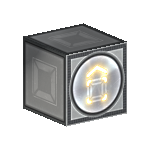Difference between revisions of "Rail Unload"
m (Now using Template:Exchanging_Rails) |
m |
||
| Line 7: | Line 7: | ||
{{production/Rail_Unload}} | {{production/Rail_Unload}} | ||
==Usage== | ==Usage== | ||
| − | A [[Rail Docker]] can be attached to a Rail Unload by using the Rail | + | A [[Rail Docker]] can be attached to a Rail Unload by using the Rail Docker's docking beam on the rail it should dock to. The arrows on the rail and docker indicate which way the docked entities will align. |
Revision as of 20:03, 6 November 2017
| This page is currently a stub. Please help us out by expanding it. |
| Rail Unload | |
|---|---|
 | |
| Hit Points | 100 |
| Armor | 60.0% |
| Mass | 0.05 |
| Luminosity | none |
| Data Value (ID) | 1105 |
Rail Unloads are special rail docks that are designed to allow any docked entity to automatically transfer items to the parent entity. The process requires permission from the parent entity as well as having Storage containers connected to the Rail Unload. It has the opposite function of Rail Loads.
Contents
Item Description
"This is the unload rail module. Docking to a block like this will pull items from the chests that are connected to the rail docker of the docked ship to the chests that are connected to this rail block. You can put more of them together to make a track. Use the 'Rail Docker' to dock to this block."
Production
| Production Info | |||||
|---|---|---|---|---|---|
| Produced in a | Standard Factory |  |
|||
| Requires | To create | ||||
| Sintyr Capsule | x10 |
 |
Rail Unload | x1 |
 |
Usage
A Rail Docker can be attached to a Rail Unload by using the Rail Docker's docking beam on the rail it should dock to. The arrows on the rail and docker indicate which way the docked entities will align.
Cargo Transfer
The primary purpose of the Rail Unload is to allow for cargo transfer between docked entities. The Rail Unload will transfer cargo from the docked entity to the parent entity.
To transfer cargo, first both the Rail Unload and the Rail Docker that is docked to it must be linked to at least one Storage block on their entity. Second, the linked storage on the parent entity must have its Auto-Pull active and defined items to pull. Third, the docked entity must give permission to have cargo transferred from it. This can currently only be done by entering the docked entity, opening the radial menu Tab, and navigating to the Load/Unload Rail Settings in the "Ship" section of the menu, and there choose the desired setting. This will cause items to be transferred from the docked entity to the parent entity. There will be no interaction with Storage blocks that are not linked to the Rail Docker or Rail Unload.
Logic Functions
When the Rail Unload receives a high signal from any logic block that is linked to it, it will release the entity that is docked to it.
Exchanging Rails
Using an Activation Module it is possible to replace or reorient rails. This is often used to switch the direction of rails, and for advanced manipulation of docked entities.
To exchange rails, place an Activation Module and link it to all rails you want to change. Place any rail with the type and orientation you want to change the other rails to adjacent to the Activation Module. When the Activation Module is activated, the rails it links to are replaced with copies of the rail adjacent to the Activation Module. To ensure this works correctly, only one rail block should be adjacent to the Activation Module.
This also works when using Button, Inner Ship Remote, and Wireless Logic Module in place of an Activation Module.
Rail Turret Axis can not be modified this way.